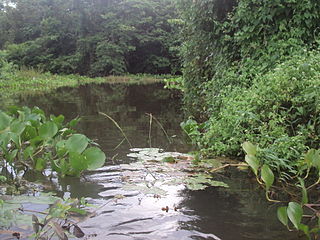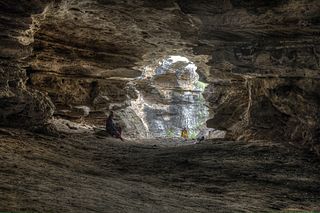
Pico da Neblina National Park is a national park in the state of Amazonas in the north of Brazil, bordering on Venezuela. It overlaps with several indigenous territories, which creates tensions over land use, as does the military presence due to the border location. The park includes lowlands around the Rio Negro, partly flooded, and mountains that include the highest peak in Brazil, after which the park is named. The wide variety of physical environments supports great biodiversity, including several endangered species.

The Cabo Orange National Park is a National park located in Amapá state in the north of Brazil, near the border between Brazil and French Guiana.

Fernando de Noronha Marine National Park is a national park in the state of Pernambuco, Brazil.
Pacaás Novos National Park is a national park in the state of Rondônia, Brazil. The park contains a mountain range by the same name.

The Pantanal Matogrossense National Park is a national park in the state of Mato Grosso at the border to Mato Grosso do Sul, Brazil.

The Serra do Pardo National Park is a National park in the state of Pará, Brazil.

Viruá National Park is a national park in the state of Roraima, Brazil. It protects an area with very infertile sandy soil, periodically flooded, that has no economic value but has exceptionally high biodiversity.
Serra Negra Biological Reserve is a Biological reserve in the state of Pernambuco, Brazil.

Anavilhanas National Park is a national park that encompasses a huge river archipelago in the Rio Negro in the state of Amazonas, Brazil. It is part of a World Heritage Site.

The Furna Feia National Park is a national park in the state of Rio Grande do Norte, Brazil that contains a large cave system.

Rio Novo National Park is a national park in the state of Pará, Brazil.

Mapinguari National Park is a national park in the states of Rondônia and Amazonas, Brazil. It covers a large area of Amazon rainforest. The boundaries have been adjusted several times.

The Campos Amazônicos National Park is a National park in the states of Rondônia, Amazonas and Mato Grosso, Brazil.

The Descobrimento National Park is a national park in the state of Bahia, Brazil.

The Serra das Confusões National Park is a national park in the state of Piauí, Brazil.

Serra do Gandarela National Park is a national park in the state of Minas Gerais, Brazil. It protects a mountainous region holding a remnant of Atlantic Forest that is an important source of water for the city of Belo Horizonte.
Acari National Park is a national park in the state of Amazonas, Brazil.
The Caatinga Ecological Corridor is an ecological corridor in the caatinga biome of northeast Brazil.
The Maurício Dantas Private Natural Heritage Ecological Reserve is a private natural heritage reserve in the state of Pernambuco, Brazil. It protects an area of dry caatinga vegetation. It was created on 12 September 1997.

The Castanhão Ecological Station is an ecological station (ESEC) in the state of Ceará, Brazil. It protects an area of caatinga vegetation adapted to arid conditions to the south of the Castanhão Dam.




















